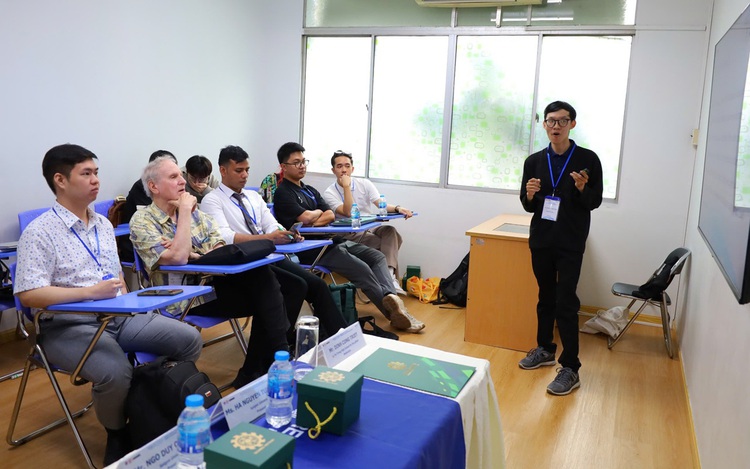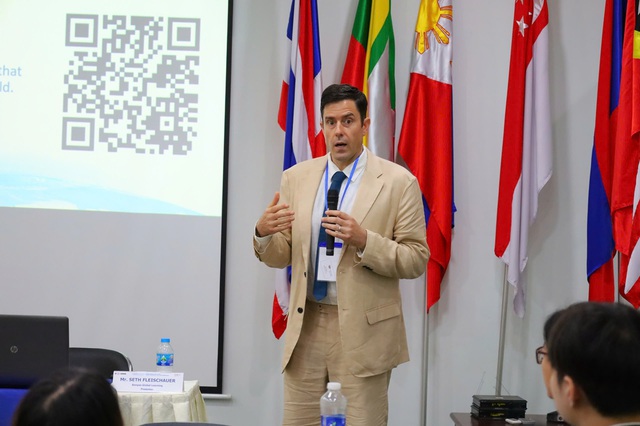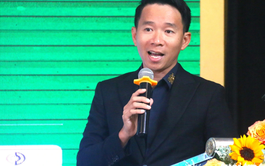
Experts from various countries participate in discussion groups during the conference program. Photo: Trong Nhan / Tuoi Tre
As institutions increasingly adopt English as the medium of instruction to enhance global competitiveness and internationalization, many face difficulties related to language proficiency, curriculum adaptation, and resource allocation.
This rapid expansion is reshaping the academic landscape, prompting calls for targeted support to ensure quality education and effective learning outcomes amidst the growing linguistic demands.
The 16th International Conference on English Language Teaching and Research, held on August 14–15 in Ho Chi Minh City, brought together more than 100 experts from India, Canada, the United States, Indonesia, the Philippines, Australia, Thailand, and Vietnam.
Organized by SEAMEO RETRAC under the theme “English-medium instruction: Global perspectives and local practices”, the event highlighted the strong global growth of EMI programs, alongside the risks they entail.
Rapid expansion without a solid foundation
Dr. Gary Bonar of Monash University (Australia), an expert in language and TESOL (Teaching English to Speakers of Other Languages), noted an alarming surge in EMI programs.
In Europe, their number grew from about 700 in 2002 to more than 8,000 in 2014. Universities in Japan, China, South Korea, Indonesia, and Vietnam have seen similar trends.
According to Dr. Bonar, the first and greatest challenge is uncontrolled expansion. Many institutions adopt EMI simply to follow the trend, but without the necessary infrastructure or support policies.
As a result, universities and students struggle with shortages from teaching materials to language support tools.
The second challenge is ambiguity about roles. EMI lecturers often see themselves as content experts rather than language teachers.
Many are hesitant or lack confidence in supporting students’ English because they fear “doing more harm than good.”
The third challenge stems from evaluation systems. At many universities, research output takes precedence over teaching in promotion and reward structures.
This discourages instructors from slowing their teaching pace, providing extra explanations, or offering targeted support for students with lower English proficiency - efforts that often go unrecognized.

International experts share diverse perspectives on the trend of English-medium instruction classes. Photo: Trong Nhan / Tuoi Tre
Insufficient skills and missing methodology
The remaining challenges concern skills and methodology.
The fourth is that many lecturers, even with strong English proficiency, still find it difficult to teach fluently or interact flexibly, particularly in unscripted situations or when quick improvisation is needed.
The fifth is a lack of teaching methodology. Quite a few lecturers are assigned to EMI courses almost immediately, without any methodological training.
Finally, EMI demands a new professional identity: lecturers must shape an entirely different “bilingual persona.”
Experiences from various countries illustrate these issues. In China, only 33.1 percent of EMI lecturers have received relevant training, and 64.7 percent reported their institutions offer no such programs.
In Turkey, even instructors with “strong grammar and vocabulary knowledge” struggle to teach smoothly in English.
In Hong Kong, educators admitted they had to prioritize research time because that is the “yardstick” for promotion.
Dr. Bonar recommended universities start with a cautious roadmap by piloting EMI on a small scale across multiple faculties to assess readiness in policy, resources, and leadership support while gathering feedback from both faculty and students.
AI - a new lever for English-medium education
Dr. Greg Kessler, professor of instructional design and innovative learning technologies at Ohio University, the U.S., suggested harnessing educational technology to boost interactivity and personalization.
He envisioned “every student having an AI tutor, every teacher having an AI teaching assistant,” alongside virtual reality, gamification, and digital storytelling.
He encouraged turning images and social media videos into engaging learning materials and exploring the “wild digital space” - open online environments that enable authentic interaction and learning beyond the classroom.
According to him, combining EMI with well-structured instructional design and diverse technologies can deliver a deep, multidimensional learning experience.



Max: 1500 characters
There are no comments yet. Be the first to comment.